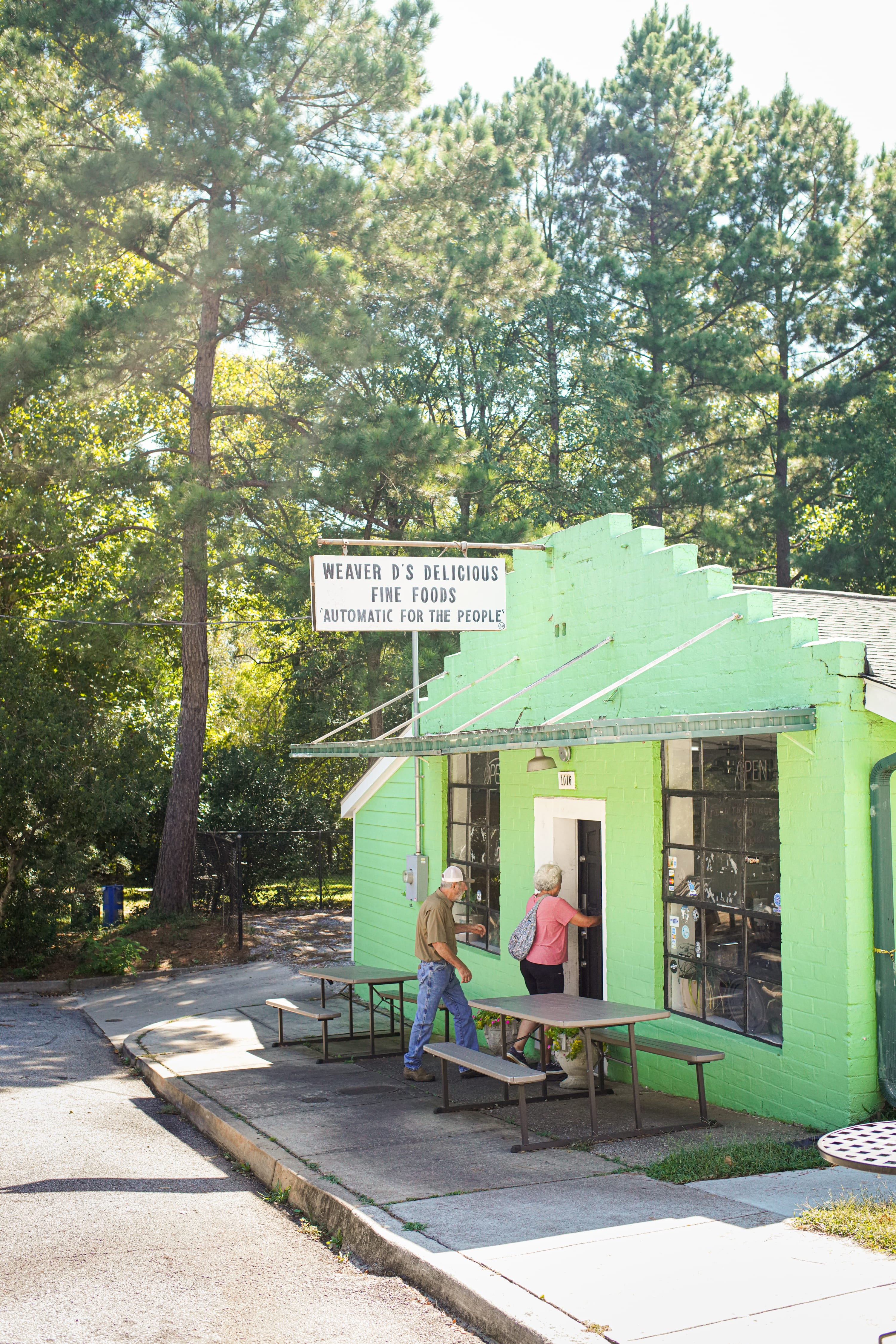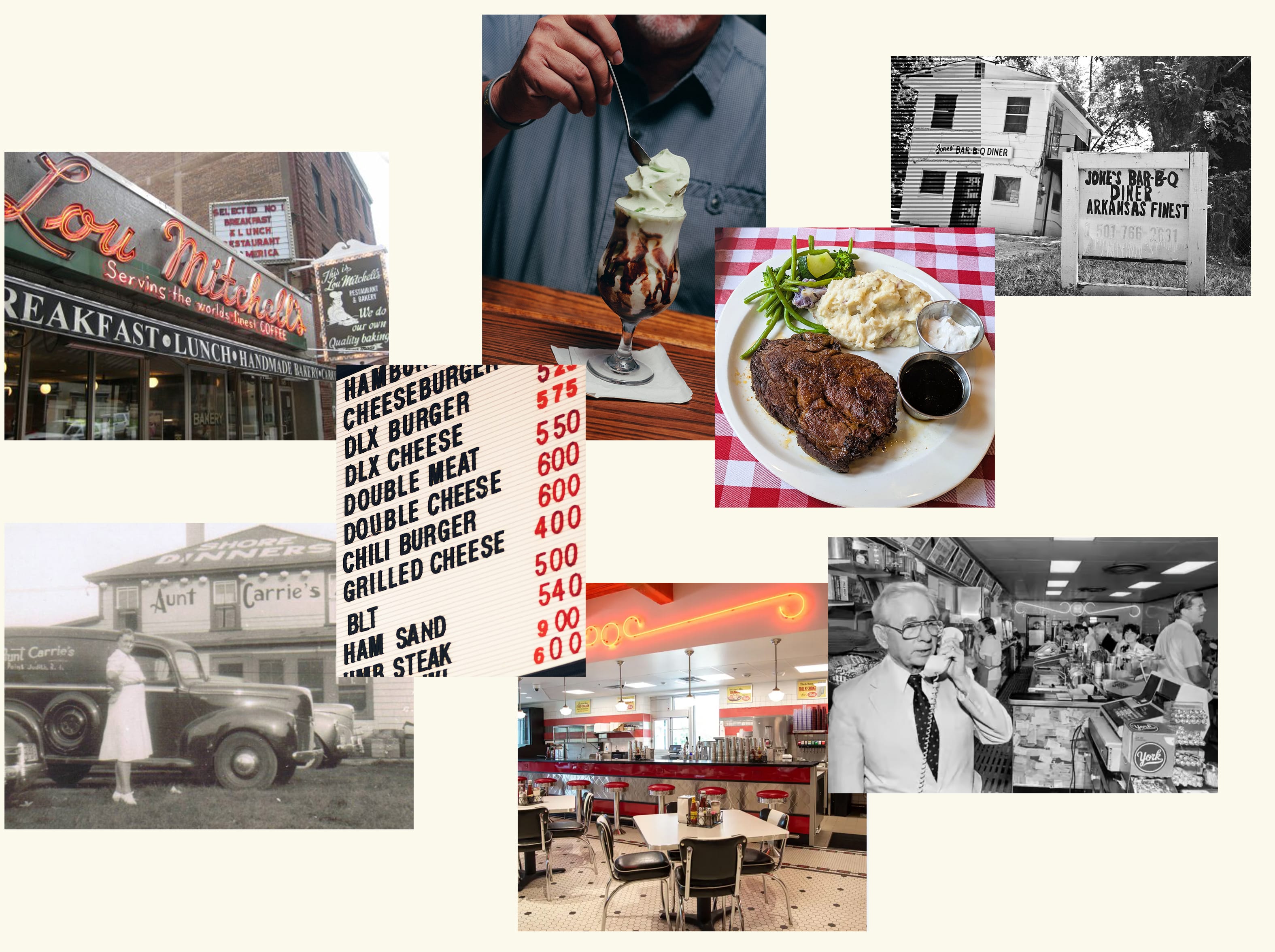
Cayce Clifford
IT’S THE ULTIMATE ROAD-TRIP TREAT, BELOVED BUT BRILLIANTLY DIFFERENT IN EVERY WEDGE OF THE NATION. COME ALONG AS WE SEARCH FOR SUPERIOR SLICES—AND THE PEOPLE WHO MAKE THEM.
The story you’re about to read is all over the map. We’re going to meet people making great things in radically different parts of the country. We’re going to hit every state at least once and some twice. (Hello, hello, Iowa.) This wide-ranging ramble is all about one thing and one thing only: the great unifier on the American road.
Pie.
Everywhere, people pull over for pie. You see it happening on the Overseas Highway, at Midway Cafe in Islamorada, Florida, halfway between Miami and Key West, where a line forms to the counter for cool slices of key lime and hot coffee. And you see it along Route 66, running through the Texas panhandle. At the halfway mark between Chicago and Los Angeles, drivers trade travel tips over slices of the Midpoint Cafe’s apple pie with green chile.
Pie also inspires pilgrimages purely for its own sake. Lovers of crust, fans of filling—they set out in search of a specific slice, or even places to serve their own. Beth Howard drove her RV across the country giving away pie, which helped heal a broken heart after her husband’s unexpected death. She made and served hundreds of slices to strangers from Venice Beach, California, to Newtown, Connecticut. She landed for a while in Iowa at the very house portrayed in Grant Wood’s American Gothic, where she sold slices to pie (and art) seekers. These days, the author of four books on pie is making a documentary called—wait for it—Piowa.
So what is it about pie? Kathy Knapp stopped for a slice, and wound up running a pie business in rural New Mexico for more than 25 years. She watched how pie makes people feel, both as tasters and makers. She’s called it a “reciprocal dopamine hit” and “emotional connective tissue.” This dish, in ways maybe unique, is a conduit for our stories, to our families and the bounty of the lands where we grow up. In a time where Amazon can deliver anything to our doors, pie can still feel deeply regional, a true discovery, yet still accessible to all—an artful and sometimes mysterious handmade expression of people and place.
Lastly, there’s the eating. Do you go point first? Or dig in where a gooey fruit center hugs to a hunk of flaky crust? More than any other dessert on the road, pie puts us in that moment, and takes us to a deeper point of connection. Hop aboard for this sweet coast-to-coast quest to find the best in every state, and meet four experts who understand pie’s magic. No better reason to hit the brakes than that.
LINH AMANDA VONG, CHEF EDUCATOR
Just off Highway 1, nestled between redwoods and coastal Año Nuevo State Park, where the elephant seals frolic, two wedge-shaped pieces of farmland touch at their tips. “We call it the lower slice and the upper slice. Pie Ranch is actually shaped in two slices of pie,” says chef educator Linh Amanda Vong. This is a spot where metaphor and mission blend together, as this nonprofit’s actual, baked pies serve several community-minded missions.
Indeed, for the local youth who visit the ranch, pie is a tool for learning about land, farming practices, cooking and the food system. “All the different components that would go into a pie, we actually grow or cultivate in some way,” Vong says. Cows produce milk and butter, workers tend to storage crops like pumpkin as well as berries and wheat, which is milled for flour.
Students can visit as part of a school program or stay for longer stretches in summer, camped out in the property’s meadow.
They’re integrated into the ranch’s operations: farming, pickling, cooking, composting and caring for the soil.
Vong came to Pie Ranch after running a Vietnamese cuisine pop-up called Auntie Manna’s. They worked in student organizations at University of California-Santa Cruz and grew food with a community garden plot run by queer and trans Asian and Pacific Islander growers, raising culturally relevant crops. These experiences culminated at Pie Ranch, where Vong helps students draw from their own cultural backgrounds and home kitchens. A surplus of cabbage might mean okonomiyaki, a savory Japanese pancake. Other days, the crew will make dumplings, curries, stews.
And pie, of course.
“You get to leave with the pie, but only after experiencing time at the farm,” Vong says. “It’s really wonderful that the promise of pie encourages a lot of youth to think more deeply about where their food comes from.
The Best Pie in Every State
We come in peace, or, um, piece. These options represent regional tastes in a quest to circle 50 pie pitstops on our map of the nation. Pin up this chart, hit the road and find your best slice in America.

EILEEN GANNON, BLUE RIBBON CHAMP


In the new Netflix cooking competition Blue Ribbon Baking Championship, Eileen Gannon bakes up a showstopper: her grandmother’s blueberry pie with an intricate honeybee-themed lattice. It’s a 133-year-old recipe that—spoiler alert!—wins an episode. “Mom would be really proud of me today,” she says to the camera.
Gannon understands how to win. She’s bagged an astounding 600 blue ribbons at the Iowa State Fair—her first at age 11. She grew up on an Iowa farm, youngest of 14, and learned to bake at her mother’s side. “It gave me an opportunity to spend time with her and do something productive, because when you’re from a very large family, you know, work is good.”
In the early days, Gannon’s family showed cattle at the fair. They camped on the grounds for the legendary event’s full two weeks. (Those coveted spots nowadays pass down in family wills.) “Us kids could take turns because we all couldn’t go at the same time,” she says now. Gannon stopped competing at the fair in 2018. After so many wins, she says, “people were kind of not as happy to see me anymore.” She still attends the fair with her chocolate sauce company, Sunday Night Foods, and she still bakes pies with her six sisters. “The fundamental science of pie hasn’t changed,” she says. “No one really has innovated it any better. That’s part of their lingering appeal.”
As for her final standing on Blue Ribbon Baking Championship, which debuted on the streaming platform on August 9? The show is an elimination competition that begins with 10 contestants from around the country. And, well, we won’t spoil it all for you. Let’s just say you’re gonna want to watch til the end.

SONYA JONES, CHEF/OWNER

The Sweet Auburn District in Atlanta buzzes with downtown energy amid layers of history. Martin Luther King Jr., born in the area, co-pastored at Ebenezer Baptist Church. Nowadays visitors can see The King Center, a nonprofit education and exhibit space. And since 1997, Chef Sonya Jones has honored another vein of history at Sweet Auburn Bread Company. She learned from her mother, who owned a cafe called Cat’s Corner in southwest Atlanta. “The sweet potatoes were warm and soft and she mashed them up with her butter and flavors,” Jones says. “For a while I had on my door that we’re ‘baking memories.’”
Jones got her formal training at the Culinary Institute of America at Hyde Park in the early ’90s, before a nationwide Southern food renaissance took hold and before many women—and especially Black women—received much restaurant-world notoriety. Jones worked in upscale pastry kitchens and taught baking classes with culinary legend Edna Lewis. (“We were like girlfriends. We would go out to eat, here and there. I remember taking her to the school in her community to vote.”) She opened her bakery as part of then-President Bill Clinton’s Empowerment Zones initiative. “At the time downtown Atlanta was not that vibrant because there were a lot of vacant buildings,” she says.

Within a couple years Clinton hailed Sweet Auburn Bread Company as a success story and came for a visit (and bite). Even still, it hasn’t always been smooth operating for Jones. Construction to put in street cars dug up the roads. A 2008 tornado caused damage nearby. Then came a recession, and later the pandemic, when Jones concentrated on farmers market sales.
These days, she looks toward retirement, with her son, Windsor, long by her side in the bakery, ready for the helm. She’s embarking on her second book project, a follow-up to her 2011 Sweet Auburn Desserts. The subtitle puts a fine point on 27 years in business: “Atlanta’s little bakery that could.”
KATHY KNAPP, OWNER


In 1995, over a Fourth of July camping trip, Kathy Knapp and her family journeyed to a speck on the map at the crest of the Continental Divide: Pie Town, New Mexico. But when they arrived, no slice of pie could be found. Most businesses were boarded up, except for a trading post dating from 1945 listed for sale. Knapp’s mother, who grew up in her mother’s Chicago cafe, was disappointed. “It’s just sad that you can’t get a piece of pie in Pie Town,” Knapp remembers her saying. “Next thing I knew, I was calling the real estate agent.”
The family brought pie back to town, with Knapp’s mother running the show until health problems exacerbated by high elevation took hold. Knapp stepped in—reluctantly at times—to learn all things pie. “It wasn’t easy,” she says. “I found my happy place. I was compelled to finish what my mom started.”
The tiny town, at least an hour from any city, mostly pulls in travelers passing through. Knapp keeps guest logs to get a sense of movement. “By the time they get here, they’re ready for a snack,” she said. “I get a little bit of everybody’s trip.”
She offers a taste of place in return—apple pies have green chile and pine nuts; chocolate chess is spiked with red chile. And she learned to watch how pie makes people comfortable. “You’d see people get happy,” she said. “I would get a high off the people’s high. I kind of see it as a self-fulfilling circle of energy.”
Knapp still owns the pie shop, and it’s still open for business. But she has retired from the day to day. She’s mulled the idea of pie classes in Pie Town at some point down the road.
“I think with anything you make with your hands, you put your energy into it. You put your time, your effort, your concerns and cares,” she said. “You’re putting your positive vibe into this piece of edible art. It has your signature.”











